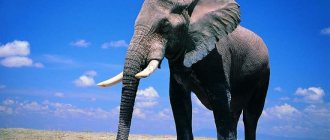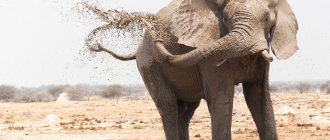Last week, representatives of several African and Asian countries agreed to jointly protect elephants. Among other things, the agreement provides for cooperation in the search and arrests of poachers and expansion of the powers of environmental agencies of the countries of the Black Continent in the fight against criminal gangs hunting the largest land animals on the planet.
Elephants are in danger of extinction. Every 15 minutes, one elephant dies at the hands of poachers on the Dark Continent. If the extermination of the largest land animals continues at the same pace, then by 2025 there will not be a single elephant left in the African shrouds.
Tanzania, for example, has already lost half of its elephants over the past three years. In 2009, according to various estimates, from 70 to 80 thousand elephants lived in this African country, that is, almost a quarter of the entire elephant population of Africa, and now - half that.
According to US Secretary of the Interior Sally Jewell
, the trade in elephant tusks, rhinoceros horns, skins and other trophies from illegal safaris has doubled in the past five years to reach $10 billion. In terms of profitability, this type of criminal activity is in fourth place.
Not only animal activists, but also politicians must fight poachers. Money from the sale of ivory, which in Africa is often called the “white gold of jihad,” finances terrorist organizations. Including Al-Shabaab, which became notorious for the recent hostage-taking in a shopping center in Nairobi.
There are the most incredible rumors about elephants. Before defending them, it would be a good idea to first understand what is true and what is fiction in them.
1. Elephants use their trunks as straws when drinking.
Elephants actually use their trunks at watering holes. They actually take water into their trunk, but then transfer it to their mouth. By the way, elephants drink a lot - on average from 140 to 230 liters per day.
2. Elephants love peanuts.
This is a pure myth, because the largest land animals do not eat peanuts either in the wild or in zoos. Considering the size of elephants, it is not surprising that
they eat most of the time. They spend 16-18 hours daily doing this activity. There is nothing in peanuts that repels these animals or is contraindicated for them. It’s just that the nuts are very small, and even 25 hours in a day are not enough for elephants to get enough of them.
3. Elephants are the only animals that cannot jump.
It's true that adult elephants can't jump, but they aren't the only ones who can't. There are many other mammals that also cannot jump. For example, sloths, hippos and rhinoceroses. True, unlike elephants, hippos and rhinoceroses can simultaneously lift all four legs off the ground while running.
4. Elephants never forget.
The largest land animals actually have excellent, but still not phenomenal, memory. The basis of their learning process is imitation. They have the heaviest brain among land animals, which weighs 5 kg. After training, they are able to distinguish and carry out over 60 commands. Elephants remember their trainers well and can remember them after many years.
5. Elephants are too heavy to swim.
On the contrary, elephants love water very much and can detect its smell at a distance of up to 8 km. Not only do they love water, but they are also excellent swimmers. There are cases when they used their trunks as breathing tubes for diving.
1. Elephants “hear” with their feet.
Elephants have excellent hearing, but African elephants, in addition to this, are able to detect earth tremors using special sensitive cells on the soles of their feet. Elephants not only hear a sound, but can also determine the direction from which it is coming.
2. The elephant's closest relative is an animal similar to a guinea pig.
Gray hyraxes are small, furry, rat-like mammals that live in the mountainous regions of Africa and along the coast of the Arabian Peninsula. Oddly enough, elephants and hyraxes actually have a lot in common in the structure of their toes, teeth and skull. Biologists believe that they had a common ancestor who lived about 60 million years ago.
3. In Chinese, “ivory” means “elephant tooth.”
Even though elephants' tusks are actually elongated incisors, they do not fall out like they do in humans. In China, where the ivory trade is thriving, not everyone understands that elephants are killed to obtain it. According to surveys, about 70% of the inhabitants of the Middle Kingdom do not know this.
4. Elephants have unusually thick skin.
The scientific term pachyderm, used to refer to the order of mammals that includes elephants and rhinoceroses, comes from the Greek word pachydermose, which translates to “thick-skinned.” Despite its great thickness, elephant skin is unusually sensitive. So much so that the elephant feels when... a fly lands on its back.
Elephants' skin is not only sensitive, but also vulnerable. Elephants can get sunburned and therefore hide in the shade or throw sand on their heads and backs to protect their skin from the sun.
5. Elephants are very sociable and social animals.
An elephant herd usually consists of 10-15 female elephants and calves. It is headed by the most experienced elephant. Having reached the age of maturity - 12-15 years, males leave the herd and return only to mate with a female. By the way, the process of bearing offspring in elephants is the longest among land animals. Pregnancy lasts 22 months.
Elephants greet each other by carefully touching the mouth of their interlocutor with the tip of their trunk. They sleep standing up and for only two to three hours. They can’t go any longer because they have to eat.
can elephants swim? and got the best answer
Answer from Rainbow Rose[newbie] The elephant is the largest mammal on our planet! The largest elephant ever to live on Earth was recorded in Angola in 1956. This male weighed approximately 12,000 kg (26,400 lb) and stood 4.2 m (13.8 ft) tall, a meter (3.4 ft) taller than the average African elephant. The smallest elephants, the size of a cow or a large pig, lived in the prehistoric period on the island of Crete. Elephants are the royal symbol of Asian culture and are known for their excellent memory and high intelligence, and are even equated with whales and hominids (belonging to the family of great apes). Aristotle once said that the elephant is “an animal that surpasses all others in wit and intelligence.” Recent discoveries have shown that elephants can communicate over long distances by producing a deep rumble that travels across the ground faster than sound through the air. Other elephants receive messages through the sensitive skin on the soles of their feet and trunks. It is believed that this is how groups call each other for help. It has long been known that the tusks of dead elephants are not found in African savannas and jungles. There was even a legend that elephants go to die in mysterious and inaccessible elephant cemeteries. In the 20th century, hunter John Hunter managed to establish where the tusks were disappearing to. He found out that African porcupines eat them, thus trying to satisfy their mineral hunger, since during the rainy season heavy rains wash away minerals from the soil. Typically, predators do not attack elephants, although lions can attack their babies and sometimes adult animals. Yet in some areas, lions regularly hunt elephants. Interesting fact: Elephants can reach 2.7m (9 ft) in height and weigh between 3 and 5 tons (3,200-4,500 kg or 7,000-12,000 lbs.) Female elephants can be up to 2.3 m (7.5 ft) in height and weighing 2.3-4.5 tons (2300-4500 kg or 5000-10000 lb.) Newborn elephant calves are born about 0.9 m (3 ft) tall and weigh 90 kg (200 lb). Despite its enormous size, the elephant has a unique sense of balance and an extremely keen sense of touch. The elephant has the largest ears of any living creature on Earth. Their skin is quite thick - 2.5 cm (1″). An elephant's brain weighs approximately 5 kg or 11 pounds (which is 4 times heavier than a human brain). The elephant swims very well, even at depth. Elephants usually move at a speed of 2-6 km/h, but for a short time they can reach speeds of up to 35-40 km/h. Elephants sleep standing up, gathered together in a dense group; only the cubs lie on their sides on the ground. Pulse - about 28 beats per minute! Photos of elephants:
Reply from 2 replies
[guru]
Hello! Here is a selection of topics with answers to your question: can elephants swim?
Reply from LORA
[guru] Yes of course!
Reply from a fan of the series
[guru] The elephant not only swims well, but can also dive under water
Reply from DDD
[guru] Yes, they can, and at a very decent speed.
Reply from Karboffos
[guru] They can. They jump into the river and dry land immediately appears.
Answer from Sasha Ptikin
[guru] Elephants, like most animals, can swim, and those who can’t swim dive!
Reply from Mujer-Aguila
[expert] They can do it very well and over very long distances...
Reply from *Julia*
[guru] I think they can!!!
Answer from V. Makarov
[gurus] can do it and not badly!
Reply from User deleted
[guru] elephants can swim.
Reply from Lady
[guru] yes
Answer from Alexey Kuznetsov
[guru] It was shown on TV that an elephant wanted to go on a party with his girlfriend on a neighboring island several kilometers away. The elephant rushes along like a tugboat, and the driver calmly cools on his neck.
Today there are many myths and rumors about elephants, and many have no idea which of all this is true and which is pure fiction. Some are even afraid of these animals because people have a misconception about them. Therefore, it is worth understanding what an elephant can do and what remains incomprehensible to it.
Briefly about elephants
In fact, this huge animal has a good-natured character. If you do not handle it roughly, it will not harm a person. On average, an adult reaches about five tons. The heart of this animal weighs on average 20-30 kilograms. The average is 70 years. At 50 years old, female elephants stop giving birth. Unfortunately, due to poaching, these animals die before reaching old age. Elephants live in herds, in which the adult female takes on the role of leader. Usually in this family everyone is related to each other, and if one member of the group dies, the rest suffer greatly from the loss of a loved one. The interesting thing is that these good-natured people know how to rejoice and even laugh. When they meet, they tenderly hug with their trunks.
Mark Spitz
Legendary American swimmer Mark Spitz is the first athlete to win seven Olympic medals in a single Games , each accompanied by a new world record. The triumphant games for Mark Spitz took place in Munich in 1972. It was only in 2008 that his record was surpassed by 23-time Olympic champion Michael Phelps . At one games he won as many as eight Olympic medals. His record remains unsurpassed so far.
Read also: How to access your email from your phone?
Mark Spitz ended his career at the age of 22 . Over the seven years of his sports career, he set 35 world records and was recognized as the best swimmer of the year in the world three times.
Mark Spitz
A little more about water
It is also known that elephants do not just swim, sometimes diving to the bottom, they are able to overcome long distances from shore to shore. Some watched this animal swim for several kilometers, after which it continued its journey on land. In addition, they can dive deep, using theirs as a snorkel. Also on the resort islands, a bathing elephant is an attraction for children who are not averse to keeping this animal company. Seeing such a spectacle, the question of whether elephants can swim will probably disappear. It can also be noted that they love water very much and can feel the moisture from another eight kilometers away.
Habitat
African elephants are called African elephants because they live on the African continent, including the territories of countries such as Sudan, Namibia, Kenya, Zimbabwe and others. Indian elephants are called Indian elephants because their habitat extends to the northeastern and southern regions of India, as well as Thailand, China, Vietnam, etc. Basically, their habitat is in protected areas, since all subspecies are listed in the Red Book. African elephants prefer to live in savannas, which are characterized by the presence of shady areas, while they avoid open areas, as well as landscapes overgrown with dense vegetation.
Elephants can be found without problems in primary deciduous forests, as well as in tropical rainforests. Part of the population prefers to live in the dry savannas of Namibia, as well as in the southern regions of the Sahara, but this should be considered more of an exception to the rule. Indian elephants prefer areas of plains covered with tall grass, as well as various shrubs, including areas with bamboo thickets. The main thing is that there is water somewhere nearby. It is very important for elephants to drink water at least once every couple of days; in addition, elephants need daily water procedures.
Let's dispel the rumors
Since elephants are the oldest animals, over many centuries different ideas have developed about them, especially among those peoples who have never “communicated” with these animals. By exploring the character and habits of the good “hulks,” you can learn and dispel five more facts and five myths about elephants. Let's start by discussing the main myths about these animals and finding out how true they are.
They do not live alone, only in herds
Elephants prefer to live in small herds of up to ten to fifteen individuals .
This is the most cohesive society when it comes to animals. They all work together to care for the young and are constantly caring for others. If one of the elephants is injured and cannot move, other elephants can bring him food and water. These animals have their own funeral ritual. When a member of the herd gets sick, he is supported if he needs to get up, fed and watered. If he does die, the whole herd falls silent. The elephants dig a small grave and throw branches and dirt over the deceased. They stay near this grave for a short time, and then go to another place.
Elephants communicate using sounds and stamping their feet. People often cannot perceive these sounds; they are low. The most respected female becomes the leader of the herd. The kids live with their herd for about 12-14 years, then they can either stay or start their own family.
Females never leave the herd unless she is caught by people. And males, growing up, first live in small herds of males, and when they become mature, they prefer to survive alone. An adult male can temporarily join a herd with females if there is at least one ready to conceive.
What the facts say
It will also be interesting to learn a few facts about these good-natured land creatures.
- Elephants have excellent hearing, in addition to which they have sensitive feet. They use them to detect tremors in the ground. With their feet they can determine where the sound came from.
- The closest relative of the elephant is the small animal gray hyrax. The structure of their skulls and legs are very similar.
- Elephants do not lose their tusks; they sit deep in the skull. To get this bone, poachers kill animals. Another 70% of the earth's population is not aware of this terrible fact.
- These animals have approximately 2.5 cm, but at the same time it is so sensitive that the elephant feels even when a fly lands on it. In addition, the skin can get burned, which is why the animal takes cover in the shade and throws sand on its head.
- If a mouse gets into the trunk of an animal, it can “shoot” it.
If you ask an adult or child whether an elephant likes water, the answer will be “Of course, yes!” After all, the picture with a huge elephant, which, while bathing in the river, releases a real fountain of water from its trunk, is firmly imprinted in everyone’s memory. Can they swim?
Elephants are vegetarians. In one day, under natural conditions, they eat about 250 kg of grass and leaves and drink about 200 liters of water. In search of pastures and watering places, these animals often cover impressive distances, which means they must somehow overcome the rivers encountered on their migration route.
The question “Can elephants swim?” simple enough. All representatives of the elephant family, like the vast majority of mammals, are excellent swimmers, although they sometimes do it with reluctance. In their habitats, shallow bodies of water are most often found, which are easier to wade. Elephants are not afraid to plunge headlong into water, and if the river is deep enough, they can walk along the bottom, breathing with the help of a trunk exposed to the surface like a periscope. In India, there was a case where a herd of elephants crossed the Ganges delta, for which they had to swim continuously for six hours. And once, during a flood, elephants swam for more than a day and covered a distance of more than 30 km.
Elephants can even swim in the ocean, swimming marathon distances. On the Andaman Islands, located in the Indian Ocean between Myanmar and India, they were used for heavy work. Since it was impossible to transport elephants from one island to another, they were taught to swim and even dive. They sailed between the islands under the supervision of drivers, covering distances of several miles. Today there is no need to use these floating giants; they have been replaced by modern boats and cranes. Brazilian photographer Daniel Botelho shot a unique underwater video in the Andamans, which has spread all over the Internet, in which the old elephant Rajan confidently swims.
For those who still doubt whether elephants swim in natural conditions, we can cite the repeatedly recorded fact of elephants crossing the strait between the African continent and the island of Zanzibar. This is excellent proof that even ocean waves are not afraid of stunning animals.
Of all the mammals that currently live on land, elephants are the largest. They have the ability to travel significant distances by land and water, live in a social structure, tenderly caring for their young, experience a variety of emotions and even listen to music. Perhaps the only thing elephants cannot do is jump.
Photos of Rajan the elephant swimming in the ocean depths have made the rounds of the internet. They were accompanied by catchy headlines like “The Only Elephant Swimming”, “The Last Elephant Swimming”, subtly instilling in readers the idea that the swimming elephant was an exceptional phenomenon. In fact, it is a matter of time for an elephant to swim from Africa to Alaska. It has long been known that elephants can swim. They are not afraid to plunge headlong into the water; they can swim or walk along the bottom, breathing with the help of a trunk sticking out above the water like a periscope. Not long ago, a case was observed in India when a herd of elephants swam across the Ganges delta for six hours. During floods, which are quite common in India, elephants sometimes have to swim for days on end, covering tens of kilometers. But it’s one thing to sail along a river or flooded area and quite another to plow the seas. However, elephants are capable of this too. Residents of the Andaman Islands taught the gray giants to swim from one island to another so as not to have to worry about transporting them. Under the supervision of mahouts, the elephants swam, covering distances of several miles. It happened that they conquered the ocean out of their own need. For example, crossing the strait between Africa and the island of Zanzibar is a repeatedly recorded fact. And yet, an elephant swimming in the ocean, not just from one island to another, but plowing, so to speak, open spaces, is a phenomenon that does not fit well in the head of a modern person. is he in the open ocean?! - Do not you say! This is exactly what the South African farmer Hag Balance, who lived in the province of Natal near Margat, thought in 1920. His house stood on the ocean, and one November morning he noticed that something strange was happening half a kilometer from the shore. It looked like there was a battle of giants going on in the water. The farmer ran into the house to get binoculars and, with his help, saw two fighting killer whales and some other animal, whose members kept appearing above the water. He was not the only one who noticed the seething near the shore. Soon a whole crowd of observers gathered on the beach. At some point, the farmer recognized the third animal and exclaimed in amazement: “It’s an elephant! I see an elephant! He was laughed at, however, everyone who looked through binoculars was forced to agree with the obvious: “Well, yes, an elephant...” The battle in the water lasted quite a long time. Then the killer whales swam away, and the carcass of the third participant in the battle continued to sway lifelessly on the waves. At night, what was left of the elephant washed up on the shore - parts of the wounded body and tusks. For several days, these remains rotted on the beach, poisoning the area with a stench. Eventually, local residents brought in a herd of bulls and dragged the carcass back into the water. The next day she was carried away somewhere by the low tide. The local newspaper reported on this strange incident. The article was reprinted by the London Daily Mail, but an elephant specialist from the Regent Zoo responsibly stated in the comment below that everything said was nonsense; the elephant could not swim in the ocean. In response, the editor received many letters from readers who talked about how they personally observed elephants swimming along the mouths of large rivers. An emigrant from New Zealand told an ancient fact, widely known in those places: at the end of the 19th century, an elephant skeleton, fairly battered by the waves, but quite recognizable, washed up on the shore in Queensland (Australia). However, it turned out to be psychologically difficult to believe that land heavyweights can swim for a long time at a depth exceeding their own height. However, the facts kept coming. In 1930, a miracle happened on Glacier Island in Alaska - an elephant carcass was caught there, and the elephant, going on this last voyage, was clearly not old. In 1944, an elephant also washed up on the shores of the Kintyre Peninsula, in western Scotland between the Firth of Clyde and the North Channel (though without a head, but this did not stop it from being identified). One can imagine how surprised the local residents were when they discovered the remains. In 1955, elephants (or rather, what was left of them) were discovered off the coast of New Zealand (near Wellington), as well as on the coast of Japan. In March 1971, an elephant's body floated to England, namely to Cornwall. A few months later, English fishermen, barely leaving the port of Grimsby in the North Sea, lifted nets with a very strange catch on board the trawler Ampoule: in addition to herring and cod, the carcass of a young African elephant was entangled in the nets... How could these land giants end up so far from their relatives places? Nobody knew the answer, but the fact itself was firmly established. Zoologists put forward different versions: maybe the elephants died near the ocean, and their carcasses were simply carried away by the tide? But then the sea salt should have eaten away their skins long ago, at least long before the current dragged them from south to north. However, all the elephant carcasses, with the exception of one, were simply surprisingly well preserved. This means that elephants remained alive at sea for quite a long time. Were they just floating in the ocean? Zoologists didn’t want to hear about this. But time passed, facts accumulated. In 1976, strange photographs sent by one of the readers appeared in a Cornish newspaper. In the letter attached to them, the woman said that the photo showed a “sea serpent” taken in the town of Trefusis Point in the local river. At first glance, it became clear that this was not a snake at all, but an elephant with its head and part of its body out of the water. However, it turned out to be easier for people to believe in the “sea serpent”. Fortunately, we remembered the story from five years ago and put two facts together. By the way, the reader herself, who sent the pictures, was sure that at the time of shooting the “snake” was alive. Literally three years later, in July 1979, it was possible to establish for sure that elephants actually swim long distances. Confirmation of this was published in the next issue of New Scientist. In the photograph taken by Admiral Kadirgam thirty kilometers off the coast of Sri Lanka, an elephant of a local breed is seen swimming in the ocean, and its body is clearly visible in the photograph. Under the pressure of facts, skeptical zoologists were forced to admit: yes, elephants can swim on the seas and oceans. True, for ordinary people this fact remained out of the ordinary. In 1982, Scottish fishermen from the city of Aberdeen again netted an elephant carcass in the North Sea. Zoologists were no longer surprised. The same cannot be said about Aberdeen fishermen.
Mammals can swim, but there is a strange exception.
“...A popular myth is that some mammals - including camels and pigs - cannot swim. A BBC Earth observer found that this is not the case: only one species of mammal is barely staying afloat. Guess which one. My girlfriend's grandparents (who are named Audrey and Hamish) are very inquisitive. They are both very interested in biology, and one day they decided to test Audrey's favorite theory. “I always believed that all mammals could, firstly, produce milk and, secondly, swim,” she says. “Not at the same time, of course.” And then one day they and their daughters gathered around the pond in the garden, taking with them their pet guinea pigs. “We had a fishing net in case something went wrong. We put the pig in the water, and it swam like a dog—if you can say that about a guinea pig—from one side of the pond to the other.” “This is our only experiment so far,” says Hamish. He believes that since most mammals walk on all fours, they must float instinctively and be able to swim like a dog. But is he right? Some mammals are undoubtedly natural swimmers. Whales, fur seals and otters have evolved to have the ability to move through water without difficulty. Many land mammals are also skilled swimmers - dogs, of course, but other domestic animals are not far behind, including sheep and cows. Even cats are good swimmers, although most of them are not very fond of this process. At the same time, other species have a reputation for being poor swimmers, such as camels. Yes, they are called ships of the desert, but why do they need the ability to swim if they rarely see water? From conversations with veterinarians specializing in camels and with breeders of these animals, it turned out that humpbacked four-legged animals, oddly enough, willingly enter the water that comes their way. This is especially true of the Kharai camels, known as the swimming camels of Gujarat. If we talk about pigs, we immediately recall a poem by the English poet Samuel Taylor Coleridge, in which the devil watches a pig floating along the river, maliciously expecting that it is about to cut its throat with its sharp hooves. But this is very unfair to pigs, as the Bahamas Ministry of Tourism will be happy to tell you. On the island of Big Major Key, a colony of seafaring pigs settled there, which became a real attraction of the archipelago, proudly calling itself the “Official Residence of the Swimming Pigs.” Previously, scientists assumed that elephants, the largest land animals alive today, could not swim. If this were true, biogeographers would have to seek complex explanations for the presence of elephant fossils on islands off the coasts of California and China, as well as in the Mediterranean Sea. In fact, elephants are excellent swimmers, capable of swimming up to 50 km at a time. Scientists even suggest that the elephant's trunk originally served as a breathing tube during swimming. Even an armadillo, despite having a bulky shell, can float on the water by swallowing air and thereby inflating its stomach and intestines, which helps it compensate for its weight. Well, that's a good start. But there are 5,416 known species of mammals in the world. To prove that they all know how to swim, you will have to throw a lot of creatures into the pond, which will not be happy about it at all. “I should note that similar experiments have already been carried out,” says Frank Fish, a swimming expert at West Chester University (Pennsylvania, USA). No one has been able to assess the swimming abilities of absolutely all mammals, but there were times when the animal was simply thrown into the water to do this. As part of their scientific work, published in 1973, Anne Dagg and Doug Windsor placed 27 species of land animals, from shrews to skunks, in a three-meter-long tank of water and saw if they could stay afloat. Fortunately, everyone knew how to swim, even the bat, which moved “with the help of heavy blows with its wings, reminiscent of the movements of a person swimming butterfly.” Unfortunately, it was often not enough for scientists to determine whether an animal could swim or not. Dagg and Windsor's work mentions research conducted in the late 50s and 60s. a series of “inhumane experiments in which animals of various species were forced to swim until they exhausted themselves or died.” Today, fortunately, such experiments are hardly possible. “Ethics are changing, and what was acceptable then is not acceptable now,” confirms Fish. Be that as it may, these experiments can serve as confirmation of Audrey’s theory, especially considering that even animals that are not adapted to life in water, such as bats, can move on water. Why is this skill inherent in so many mammals, even those who have no need to swim? According to Fish, this is a side effect of their anatomical structure. “Mammals have fairly large lungs, which gives them good buoyancy,” he explains. “Hair is also important, but the larger the animal, the less it means to it.” “All of these factors allow mammals to float,” says Fish. “And if you can float, you can swim.” Does this mean that absolutely all mammals can swim? One work on the delightfully exotic subject, Swimming Capabilities of the Golden Hamster, dated 1963, states: “It is widely known that most wild mammals can swim.” Most, but not all. From the scientific literature it follows that scientists agree that there are two groups of non-swimming mammals: giraffes and great apes. Judging by their appearance, giraffes clearly do not look like natural swimmers. With such an unusual body structure, it seems quite plausible that this animal is unlikely to be able to stay afloat. No one has yet taken the gamble of creating a water tank the size of a giraffe, but thanks to the curiosity of some paleontologists, this may not be necessary. Interested in numerous references in the scientific literature that giraffes cannot swim, scientific author and paleontologist Darren Naish decided to test this hypothesis. “I am very skeptical of such claims, especially since other animals previously thought to be unable to swim, including giant tortoises, pigs, rhinoceroses and camels, are actually good or even very good swimmers,” he wrote in on his Tetrapod Zoology blog. To design an ethically acceptable experiment that did not require water, Naish contacted Donald Henderson of the Royal Tyrrell Museum of Paleontology in Drumheller, Alberta, Canada. Henderson specializes in creating computer models of animals, both extinct and extant. “I originally created these models to study animal locomotion and determine their body mass, but then I realized that they could also help estimate swimming ability,” he explains. By a happy coincidence, Henderson already had a ready-made model of a giraffe, so the scientists decided to finally determine whether a giraffe could float on water. “We found that a giraffe would be able to stay afloat with its head close to the surface, but water would constantly be getting into its nostrils,” Henderson says. He explains that due to its long limbs, this animal will move very clumsily through the water. “A giraffe will still be able to swim, but it will be very difficult for him, and I understand why giraffes are reluctant to try,” he concludes. The swimming abilities of primates were tested in much less humane ways. Ethologist Robert Yerkes tells a story that happened at the beginning of the 20th century. William Hornaday, founder of the Bronx Zoo, took a pet orangutan to a stream to bathe. “Having positioned him above the water, I let him go, even though he resisted. Did he swim? Hardly. In the blink of an eye, he turned upside down, and his head went down, as if there was lead in it instead of a brain,” he writes. Unfortunately, this cruel experiment is no exception. Yerkes himself describes throwing young chimpanzees into water to see if they would sink or swim. “Everyone, without exception, was actively floundering in the water and quickly sank,” he notes. This is why zoos often use water ditches to prevent primates from escaping. Hornaday also wrote that "instead of vigorously swinging his arms and legs, as other animals do, he (the orangutan) simply spread them apart, and they stuck out from his body like sticks, which he moved slowly and sluggishly." Obviously, there is something that prevents great apes from coordinating their movements when swimming. “Many people think that chimpanzees can’t swim because they can’t float,” says Renato Bender, a researcher at the Institute of Human Evolution at the University of the Witwatersrand in South Africa. “But that’s not the point, it’s the swimming technique.” In his opinion, most mammals swim instinctively, since they essentially perform the same movements as on land (as my friend's grandfather suggested). “When swimming, tetrapods are actually using an already established motor pattern,” says Fish. That is why four-legged animals swim like dogs. George Wilson of the Australian National University in Canberra notes that kangaroos may dive into the water to escape predators. According to his observations, when a large red kangaroo with no swimming experience enters the water, even it swims like a dog, despite the fact that it moves by jumping on land. He concludes that this may be a "return to the past" of their evolutionary history. Even the creatures most adapted to an aquatic environment swim in much the same way. “The dolphin actually runs underwater, albeit without legs,” says Fish. But primates are also quadrupeds, so why doesn’t this logic work in their case? In 2013, Bender and his wife Nicole, a physician researcher at the University of Bern in Switzerland, questioned the conventional wisdom that primates cannot swim. They filmed a video of a chimpanzee named Cooper and an orangutan named Suriya swimming across the pools without any problem. This was the first video evidence that great apes are still capable of swimming. The primates that were filmed did not know how to swim from birth, they had to learn it. Bender, who had previously worked as a swimming coach, noticed one important feature of their technique: they swam breaststroke rather than doggy style. In his opinion, such differences in swimming techniques did not arise by chance, but appeared in the process of evolution. The ancestors of these primates adapted to life in the trees, no longer needing to enter the water, and their nervous and motor systems and anatomical structure underwent changes that allowed them to move more dexterously in the trees. As a result, the ancient ancestor of primates lost not only the desire, but also the ability to swim like a dog. In the rare cases when primates do learn to swim, the increased mobility of their limbs associated with life in the trees makes it a more natural movement for them to push off the water with their legs, characteristic of breaststroke. This suggests that swimming is not just a beneficial side effect of being buoyant and having four limbs. Through the process of natural selection, the ability to swim in all other mammals was actively maintained. However, Fish believes that this theory is far-fetched. “Mammals became unaccustomed to water during the Devonian period, when sea creatures began moving onto land,” he explains. “Too much time has passed to hope for a return to the past.” Nevertheless, Audrey's hypothesis is not far from the truth. It turns out that swimming has played a surprising role in the lives of animals, and perhaps this skill is much more important than we previously thought. It is impossible not to mention a mammal for which swimming went far beyond the scope of biology - another non-swimming great ape, humans. There is a common belief that children can swim from birth - perhaps for some it is associated with the famous Nirvana album cover. However, in reality this is not the case. Babies do hold their breath when submerged in water, but this should not be confused with swimming. Breath-holding is part of the mammalian dive reflex, a set of physiological changes associated with immersion that is common to all mammals (and most pronounced in marine species). Just like Cooper and Surya, our fellow primates, humans have to learn to swim. But, being smarter primates, we have learned to do it quite well. The world's best divers and Olympic swimmers set records unthinkable for any other land mammal. People learn to swim for work and leisure, as well as for certain cultural reasons. Our strong love of water, compared to other primates, was one of the traits on which the so-called aquatic theory arose. It states that many of the defining characteristics of humans (lack of hair, bipedalism, large brains, etc.) were formed during that period of our evolutionary history when we led a semi-aquatic lifestyle. Despite the fact that the aquatic theory lacks scientific evidence, it has quite a lot of supporters. Bender believes its popularity has hampered serious research into primates' relationship with water and the influence that the water element may have had on our behavior and evolution. “I would like people to understand that we need to separate the ‘role of water in human evolution’ from the aquatic theory and then start studying it using scientific methods,” he says. “There is a lot of evidence that chimpanzees and orangutans will play with water for hours. Water is of great interest and attracts smart animals, and we are just smart animals,” says Bender…” https://www.bbc.com/russian/vert-earth-40776241
Briefly about elephants
In fact, this huge animal has a good-natured character. If you do not handle it roughly, it will not harm a person. On average, an adult reaches about five tons. The heart of this animal weighs on average 20-30 kilograms. The average lifespan of an animal is 70 years. At 50 years old, female elephants stop giving birth. Unfortunately, due to poaching, these animals die before reaching old age. Elephants live in herds, in which the adult female takes on the role of leader. Usually in this family everyone is related to each other, and if one member of the group dies, the rest suffer greatly from the loss of a loved one. The interesting thing is that these good-natured people know how to rejoice and even laugh. When they meet, they tenderly hug with their trunks.
Self-awareness is inherent
For a long time, people believed that animals lacked self-awareness. But zoologists tried a mirror test. Those who look in the mirror react to their reflection as if they were someone else, or themselves, if they recognize themselves, then this proves the presence of self-awareness. Scientists have discovered that elephants have self-awareness . There were other experiments that could confirm this. Researchers from Cambridge conducted such an experiment. The elephant was supposed to give the stick by picking it up from the mat, but it was tied to the mat with ropes.
The animal stood on this carpet and tried to pass the stick to the person, but it did not work. But if it had come off the mat, he would have been able to complete the task. And the elephants left the mat, thereby showing that they could perceive their body.
A little more about water
It is also known that elephants do not just swim, sometimes diving to the bottom, they are able to overcome long distances from shore to shore. Some watched this animal swim for several kilometers, after which it continued its journey on land. In addition, they can dive deep, using their long nose as a snorkel. Also on the resort islands, a bathing elephant is an attraction for children who are not averse to keeping this animal company. Seeing such a spectacle, the question of whether elephants can swim will probably disappear. It can also be noted that they love water very much and can feel the moisture from another eight kilometers away.
Long distance swimmers
Elephants are indeed bulky, but their clumsiness is deceptive. We must remember that elephants can travel up to 130 kilometers a day or more in search of food and water. This means that their legs, which must bear the weight of the body, are very muscular and strong.
Combined with their ability to use their trunk as a snorkel, this allows them to swim for hours on end. They can also spread their feet to help their enormous mass move through the water.
Elephants don't get tired as quickly when swimming. But if this happens, they will simply rest in the water for a while. Thanks to their buoyancy, they do not sink. In Africa, elephants have been recorded to travel 48 kilometers across water. They also swam for six hours continuously.
Experts believe that the elephants found in Sri Lanka are descendants of elephants that crossed the sea from South India. The only limitation that forces the elephant to look for land while swimming is hunger and thirst for sea water.
Nutrition
Given the huge size of elephants, these giants need a large amount of food. Elephants spend approximately 16 hours a day absorbing food; on average, an elephant eats 300 kg of vegetation per day. The food for herbivorous giants is grass, rhizomes,
leaves of trees, fruits of wild bananas, apples. The migrations of African elephants are associated with the search for food; usually a herd of elephants stays in a certain area until it is completely devastated, and when all the grass and all the leaves around are eaten, the elephants set off in search of new pastures with lush vegetation. Also, sometimes elephants cause significant damage to crops of corn, sweet potatoes and other agricultural crops. Elephants take food with their trunk and chew it with their molars.
Also, elephants not only eat a lot, but also drink just as much. An adult elephant drinks from 100 to 300 liters of water per day. It is not surprising that elephants are always near bodies of water.











